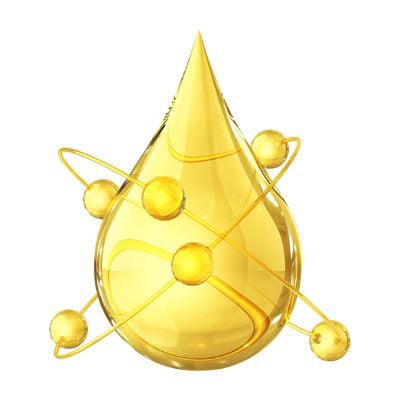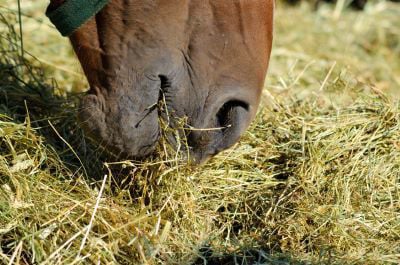Slow and fast release energy sources for horses are often a topic of hot conversation and can lead to some confusion.
Different types of feed are digested at different rates, leading to differing rates of immediate energy availability in the working muscle. However, the availability of macronutrients from recently consumed feed isn’t always directly related to the fuel source in use within the working muscle.
A horse’s energy sources can be broadly split into three categories: Starch and sugars, oils and fats, and fibre.
Starch and sugars
Starch and sugars are primarily found in grain feeds and, in variable quantities, grass. As starch is a large molecule it cannot be absorbed through the small intestine, but must be broken down into smaller units by an enzyme called amylase. The resulting maltose, and any other disaccharide sugars consumed by the horse, are further broken down by their respective enzymes and can then be absorbed straight into the blood stream from the small intestine.
The horse’s ability to produce amylase is limited, so if a large quantity of grain or hard feed is given in one meal the starch passes through to the hindgut where it is fermented by the gut microbiota.
Although this does mean the starch can be digested and absorbed, it results in increased levels of lactic acid as a by-product which lowers the pH of the hindgut and unfavourably alters the balance of the gut microbiota. The degree of processing undergone by the grain prior to feeding, and type of starch, affects the amount of time it takes for the resulting sugars to be absorbed into the blood stream. However, between the different sources of energy, starch and sugars have the shortest time of all feeds between ingestion and availability for energy.
The fructans found in spring grass are another large molecule that needs to be broken down before absorption, however, horses lack the ability to make the necessary enzymes, so it passes through to the large intestine where it is fermented by the gut bacteria, in a similar way to excess starch, with much the same results.

Oils and fats
Oils and fats are first broken down by enzymes in the stomach and small intestine which, along with the bile salts released from the liver, allows them to be packaged into chylomicrons which are absorbed through the small intestine into the lymphatic system or blood stream from where they are taken via the portal vein to the liver to be further processed and distributed.
Although horses don’t have a gall bladder, bile is constantly released from the liver into the small intestine, and as a result digestibility of dietary fats is estimated to be as high as 90%. The time between a horse ingesting the fats with their feed and it being available to use for energy varies between approximately 2-4 hours.

Fibre
Digestible fibre provides the majority of the energy for most horses, except those in very hard work. Fibre is digested by the microbiota in the caecum. The interesting Volatile Fatty Acids (VFA’s) produced through fermentation from an energy perspective, are acetate, propionate and butyrate. While butyrate is used as a source of fuel for the cells that line the intestinal tract, acetate is primarily used as a direct fuel source in the muscle or stored as fat. Propionate undergoes a process called gluconeogenesis in the liver to produce glucose for immediate metabolism in working muscle, or storage as glycogen in muscle or liver.
As fibre fermentation is (or should be, depending on the forage intake) an almost continuous process in the hind gut, production of VFA’s provides a continuous source of steadily and slowly released energy.

Considering energy sources for your horse’s needs
As a horse begins exercising, mitochondrial activity in the muscle increases. Mitochondria are like a fireplace, in that a fuel source and oxygen are combined to create energy. This is in the form of Adenosine Triphosphate (ATP). The fitter a horse is the more mitochondria each muscle cell will have, so in effect more fireplaces, which means a greater capacity to produce energy. More ATP can be produced per molecule from fat than carbohydrate, but the process is much slower. Fat also requires a much higher oxygen contribution per molecule for metabolism. At maximal exercise capacities, delivery of oxygen to the working muscle is therefore another limiting factor for fat metabolism. As such, fat metabolism is ideally suited to low and moderate intensity exercise, while carbohydrate in the form of glycogen storage is predominantly used for high intensity work. As such, the composition of the last meal and whether it was quickly or slowly digested, is largely irrelevant as it is the stored muscle glycogen that will be preferentially metabolised.
Summary
In terms of digestion, starch and sugars are absorbed fastest, with fats and oils taking a little longer and the energy from fibre taking the longest to reach the muscle.
Energy stored as muscle glycogen is created from starch, sugar and the VFAs that are the products of fibre fermentation. Glycogen can be metabolised quickly and provides energy for high intensity work.
Fats provide more energy per unit than glycogen, but take longer to metabolise in the mitochondria so are preferentially metabolised during low to medium intensity work.


_800.png)